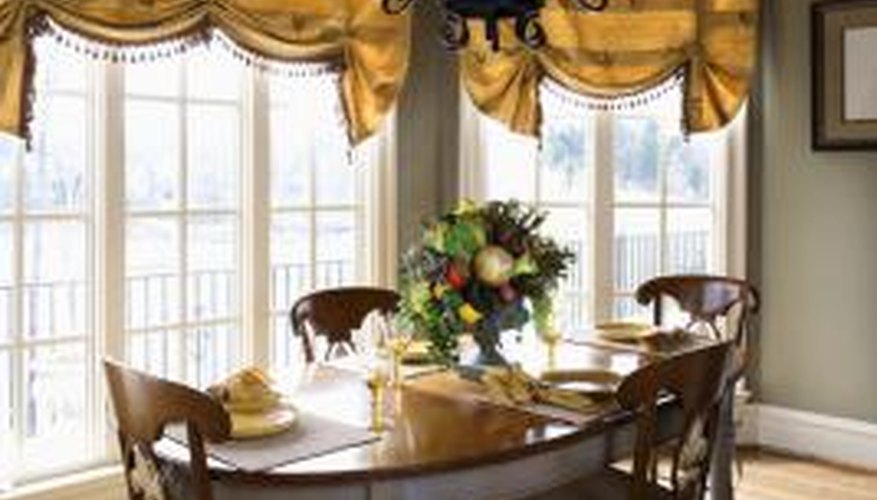London blinds are a modified soft Roman blind. Usually the London blind has two deep pleats that run the height of the blind and when the blind gathers the pleats open and the fabric between the pleats swags softly along the bottom edge. This is a stylish blind that can be upgraded by using a different colour fabric inside the pleat for an unexpected pop of colour. The simple version of this blind is well within the reach of most crafters and a blind can usually be made in a few hours.
- London blinds are a modified soft Roman blind.
- Usually the London blind has two deep pleats that run the height of the blind and when the blind gathers the pleats open and the fabric between the pleats swags softly along the bottom edge.
Measure the width of the window and cut a piece of 1-by-1-inch wood board (batten) with a saw. Screw the batten into the top underside of the window casing as close to the window as possible. Use long screws and a screwdriver.
Measure and cut hook and loop tape the width of the batten. Attach the adhesive hook portion of the tape to the top front of the batten. Set aside the loop portion for later.
Measure the width of the window and add 12 inches for each pleat and 1 inch for seams. Typically, your London blind will have two pleats. Measure the height of the window from the top of the batten to the window sill. Add 1 1/2 inches. Launder and iron your fabrics. Cut your fabrics to these measurements.
- Measure and cut hook and loop tape the width of the batten.
- Measure the width of the window and add 12 inches for each pleat and 1 inch for seams.
Place the fabric's right sides together and sew down both sides and across the bottom. Clip the corners. Turn the fabric right side out and iron.
Position your blind on a flat table lining side up. Place the blind lengthwise so that the raw top edge is to your left and the bottom is to your right. Measure from the current top (actual side) 6, 12 and 18 inches. Draw three horizontal lines along the length of the blind with tailor's chalk. Mark an "X" on the 12-inch line. Measure from the current bottom (actual side) 6, 12 and 18 inches repeating what you did earlier.
- Place the fabric's right sides together and sew down both sides and across the bottom.
- Measure from the current bottom (actual side) 6, 12 and 18 inches repeating what you did earlier.
Cut Austrian blind tape the length of your horizontal drawn lines. Cut the tape in half lengthwise and pin each tape to the X marked 12 inch line. The bottom loop of each Austrian tape should be 2 inches from the bottom of the blind. Pin and sew the Austrian tape centred on the X lines. Turn under each end for neatness. Sew a seam on both sides of the rings sewing in the same direction to prevent puckers.
Turn the blind over so that the decorator fabric is facing upward. Fold the fabric face sides together over the Austrian tape so that the 6- and 18-inch lines match. Sew 4 inches from the top edge securing the ends well. Sew 2 inches from the bottom edge securing the ends well. Repeat for all pleats. Center your ring tape over your seam and iron your pleats from top to bottom.
- Cut Austrian blind tape the length of your horizontal drawn lines.
- Fold the fabric face sides together over the Austrian tape so that the 6- and 18-inch lines match.
Fold the top edge under 1 inch. Fold the folded edge under 1 inch. Pin the loop portion of the hook and loop tape to the back top edge of the fabric centred in the 1 inch. Sew two parallel seams across the length of the tape. Sew in one direction to prevent puckers.
Cut cording twice the length plus the width of the window for each of your pleats. Tie a cord to the bottom most ring. Thread the cord up from bottom to top through all of the vertical rings in that column. Repeat for each pleat and Austrian tape. Attach the blind to the batten by pressing the hook and loop tape together.
- Fold the top edge under 1 inch.
- Cut cording twice the length plus the width of the window for each of your pleats.
Screw a screw eye into the underside of the batten just above the last ring on each tape. Screw an extra screw eye to the side where you want the cords to operate. Thread the cord through the screw eye above the cord and through each screw eye toward the extra screw eye. Thread all cords through the extra screw eye.
Open the blind fully. Measure 8 inches from the extra screw eye. Attach a cord condenser to the cords. A cord condenser is a device that turns many cords into a single cord. Slide an acorn over the single cord and tie a knot in the cord. An acorn is a plastic or wood cup-shaped piece that slides over the knot to make the cord easier to pull. Screw a cleat to the wall well above where children can reach. A cleat is a two-headed hook that you wind the cord on after you open or close it.
- Screw a screw eye into the underside of the batten just above the last ring on each tape.
- Slide an acorn over the single cord and tie a knot in the cord.
TIP
After making a few London blinds, consider adding a different colour fabric between your 6- and 18-inch marks. This will create a pop of colour when the pleat opens.
